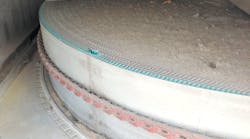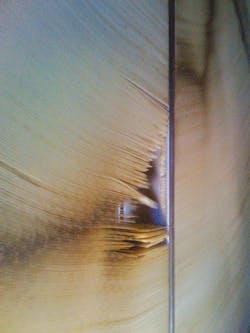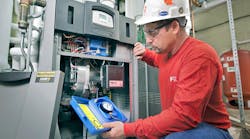Over the last 10 years, there has been a tremendous upsurge of energy recovery ventilators (ERV), dedicated outdoor air dehumidifiers (DOAS) and other HVAC systems units using desiccant-based enthalpy wheels. Consequently, many HVAC service contractors are increasingly confronted with desiccant wheel repair, service and replacement work, as these systems reach the end of their lifecycles.
ERVs are energy add-ons to conventional rooftop package HVAC systems.Because they’re designed to dehumidify and cool outdoor air in the summer by recovering exhaust air they significantly cut energy costs by reducing the rooftop system’s air conditioning load. DOAS systems are designed to dehumidify outdoor air and reduce the building’s air conditioning load.
Initial Diagnostics
High space humidity complaints in buildings with desiccant systems may indicate a failed desiccant wheel or failure of a process associated with it. After a quick visual check to see if the wheel is clean and turning, diagnostics should concentrate on routine refrigeration parameters.
When refrigeration parameters check out, operational trends and diagnostic history in the microprocessor-based control should be checked. Older, low tech models won’t have logging or time/date features. However, a front-end building automation system (BAS) microprocessor that’s set up to monitor and control the unit may hold that data.
Once refrigeration and control diagnostics are completed, wheel performance should be checked. Wheels turn at different rates according to brand. The wheel’s speed and sequence of operations can be found in the installation operation manual (IOM). If the system is economizing and the wheel is turning, there’s a sequence of operation or control programming problem.
Since most older desiccant systems exhibiting humidity reduction problems won’t have sophisticated diagnostic controls, temperature and humidity readings should be checked relative to the wheel. A temperature drop of 10 to 20F through the wheel indicates it’s working properly with regards to temperature. The return air temperature from the space is important for wheel function also. Without a temperature difference, there’s nothing for the wheel to work with to drop the humidity.
If the humidity isn’t dropping through the wheel, then manufacturer’s specifications should be checked because some wheels only control sensible humidity, not the latent load.
It’s important to note that depending on the design of the wheel and the desiccant application, there may be degradation of moisture transfer. The closer the absolute humidity discharged from the wheel is to the outdoor humidity (in summer/winter operation) the greater the potential that the desiccant has deteriorated.
Ideally, a log of operations should be performed by downloading into the service laptop computer, or manually filling out a log form for units without computer connections.
Wheel Diagnostics
A building maintenance staff that has neglected changing media filters regularly on an ERV, inadvertently turns a wheel into a filter that’s caked with dust and debris. Brushing with a soft bristle brush and vacuuming airborne dust can remove it. For extra dirty wheels, a mild solution of dishwashing soap and water can be used. Coil cleaners and other toxic chemicals shouldn’t be used, because of potential damage to a wheel’s protective coating, not to mention residual fumes that can infiltrate into the space’s air supply. One note of caution: depending on the wheel manufacturer’s process to apply the desiccant, it’s possible that the desiccant can be removed. Those manufacturers using a ceramic-based desiccant that’s permanently bonded to the wheel will have less problems than those who dust coat or impregnate the media with desiccant.
Leaking seals between the wheel and the chassis are also suspects in humidity complaints because unconditioned outdoor air enters downstream from the wheel. Seals in need of replacement or adjustment drag the wheel revolutions down to an ineffective speed.
Since the seal should be close, but not in contact with the wheel, a handheld piece of 20-gauge sheet metal makes a nice seal/wheel gap gauge.
Besides seals, outdoor air can also circumvent the wheel through poorly-fitting or dented unit jackets or doors.
Likewise, a building operating under negative pressure can draw air from the outside through building imperfections. This can occur relatively unnoticed, for example if an exhaust fan is left in an operational mode and continually pulls out more air than the ERV or rooftop system supplies. Correcting negative pressure sources can reverse high humidity.
Most BAS can provide read-outs or histories of building pressure. Other investigations should concern the building’s total air distribution design, such as return and supply air grilles, which might also reveal high humidity sources.
The wheel’s motor and belt is another check point. All desiccant wheel brands are belt-driven. Many brands use a chain-like rubber belt around the wheel’s circumference that’s turned via the motor pulley. Unlike the rule of thumb of a one-inch belt deflection for conventional motor/blower fan belts, wheel belts operate best with a three or four-inch deflection. The belt is installed similar to a dryer drum, where there’s a motor sheave in one corner and a tensioner in another. The friction of the belt on the circumference of the wheel is adequate to turn the wheel assuming the wheel bearings are appropriately lubricated and do not drag of their own.
Like conventional blowers and motors, wheel belts can also slip and trip a motor off on overload.
Wheel Replacement
Aluminum wheels rarely need replacement unless they’re severely damaged, however wheels made of less expensive materials such as plastic or fiber composites do wear out and may need periodic replacement. Wheel replacement typically requires two service techs especially on larger wheels that weigh dozens of pounds. Careful handling is important, because bending or breaking the media’s edges will affect static pressure.
Depending on the manufacturer, wheel replacement can be a drop-in process with some follow up calibration and leveling. However, sometimes brace supports block access with a level. In those cases, measuring from several wheel perimeter points to the unit encasement above or to the wheel chassis below can help level a wheel.
Wheel Freezing
Another common source of failure is wheel freezing in northern climates. Certain brands of wheels are more prone to freezing, even when temperatures are as high as 20F. The units might also include electric heat strips to preheat the outdoor temperature enough to prevent freezing when combined with the humidity of the exhaust air. Consequently, the wheel is slowed down to prevent frosting, but requires expensive reheating to reach space temperature set points. Some manufacturers start the frost control at 32F to avoid freezing. Other manufacturers put in condensation control algorithms in their controllers or have a true enthalpy wheel, which means that the wheel has equal sensible and latent transfer. When you have equivalent latent transfer, the wheel will likely not have a frosting condition until 0F.
Training Maintenance Staffs
A building’s properly trained maintenance staff can be the service contractor’s eyes and ears in between annual service. Motors and bearings that aren’t sealed should be greased properly every six months to a year. Filters need inspection every month and a periodic replacement every three months. Outdoor air and exhaust air dampers need inspection and periodic lubrication for free linkage movement.
Outdoor air settings need to be inspected. Maintaining minimum requirements outdoor air in accordance with ASHRAE Standard-62 will provide the building owner with the greatest operational efficiency and subsequently energy savings.
Untrained maintenance personnel can also cause problems. There have been instances where high humidity complaints have prompted maintenance staffers to block the outdoor air intake and or remove filters altogether, the latter which makes the wheel itself a filter.
Sidebar: Wheel Maintenance Overview
There are three main types of enthalpy wheel substrates—plastic, fiber composite and aluminum. Many contractors and facility engineering staffs have the false perception that all enthalpy wheels require high maintenance and multiple replacements. While it’s true that some high maintenance OEM enthalpy wheels entered the industry several decades ago and are still available today, there are other enthalpy wheel technologies that have proven to operate without these issues.
Some wheels available today are still high maintenance and have a short lifecycle, however they serve an economic purpose. Another consideration are wheel designs that incorporate methodology that functions more like a filter than an enthalpy device because their flutes aren’t well designed. They transfer energy, but increase the chances of clogging due to design limitations. Therefore, maintenance is an issue. These lightweight wheels that typically range from two to four-inches-deep are meant to be replaced periodically and maintained several times a year.
Another disadvantage in the plastic and fiber composite wheels is the tendency to increase static pressure, due to their impeding airflow construction. Aluminum wheels have larger flutes, which creates a non-turbulent laminar flow that minimizes static pressure loss and increases system efficiency. The lower pressure drop, in comparison to other wheel styles, results in reduced fan horsepower requirements.
An aluminum substrate wheel combined with 3 angstrom (3A) molecular sieve desiccant material creates a heavy-duty, four to 10-in. deep aluminum wheel that never needs regeneration or replacement and requires little maintenance. The wheels transfer sensible heat through passing the aluminum media between the two airstreams and the latent energy via the desiccant material (spong) that resides on the aluminum surface.
Steven Crocker is service manager and Peter Smith is a service engineer for Halvorson Trane, Des Moines, IA. They have more 34 years combined in HVAC service. Halvorson Trane is a 67-year-old company specializing in sales, service and commissioning of HVAC systems.













